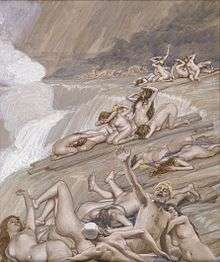List of flood myths
The flood myths or deluge myths are, taken collectively, myths of a great flood. These accounts depict global flooding, usually sent by a deity or deities to destroy civilization as an act of divine retribution. Flood stories are common across a wide range of cultures, extending back into prehistory. Below is a list of some flood stories from around the world and is in no way exhaustive.
West Asia and Europe
Ancient Near East
Sumerian
Babylonian (Epic of Gilgamesh)
Abrahamic religions (Noah's flood)

Classical Antiquity
Medieval Europe
Irish
Welsh
Norse
Modern era folklore
Finnish
Africa
Many African cultures have an oral tradition of a flood myth including the Kwaya, Mbuti, Maasai, Mandin, and Yoruba peoples.[1]
Asia-Pacific
India
- Manu and Matsya: The legend first appears in Shatapatha Brahmana (700–300 BCE), and is further detailed in Matsya Purana (250–500 CE). Matsya (the incarnation of Lord Vishnu as a fish) forewarns Manu (a human) about an impending catastrophic flood and orders him to collect all the grains of the world in a boat; in some forms of the story, all living creatures are also to be preserved in the boat. When the flood destroys the world, Manu – in some versions accompanied by the seven great sages – survives by boarding the ark, which Matsya pulls to safety.
- Puluga, the creator god in the religion of the indigenous inhabitants of the Andaman Islands, sends a devastating flood to punish people who have forgotten his commands. Only four people survive this flood: two men and two women.
China
Korea
- Mokdoryung
Malaysia
Tai-Kadai people
There are stories spoken by Tai-Kadai people, included Zhuang, Thai, Shan and Lao, talking about the origin of them and the deluge from their Thean (แถน), supreme being object of faith.
- Khun Borom
- Poo-Sankhasa Ya-Sangkhasi or Grandfather Sangkhasa and Grandmother Sangkhasi, who make the human beings and the deluge.
Philippines
The Igorot tale:
Once upon a time, when the world was flat and there were no mountains, there lived two brothers, sons of Lumawig, the Great Spirit. The brothers were fond of hunting, and since no mountains had formed there was no good place to catch wild pig and deer, and the older brother said:"Let us cause water to flow over all the world and cover it, and then mountains will rise up."
Oceania
Polynesia and Hawaii
Americas
North America
- Hopi mythology – Entrance into the Fourth World
- W̱SÁNEĆ peoples, flood myth [3]
- Comox people – Legend of Queneesh
- Anishinaabe - The Creation Story - Turtle Island [4]
- Inuit, flood myth [5]
Mesoamerica
South America
Canari
Inca
Mapuche
Muisca
Tupi
References
- ↑ Lynch, Patricia (2010). African Mythology, A to Z. Chelsea House. p. 45. ISBN 978-1-60413-415-5.
- ↑ sacred-texts.com
- ↑ SENĆOŦENStory – ȽÁUWELṈEW, FirstVoices.com
- ↑ , Grand Council Treaty #3, The Government of the Anishinaabe Nation in Treaty #3
- ↑ , Flood Stories from Around the World, TalkOrigins.org